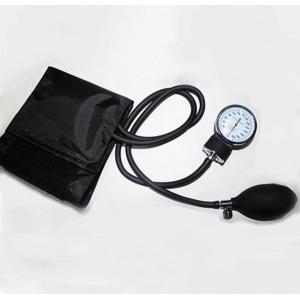Aneroid Sphygmomanometer with Stethoscope – Manual Blood Pressure Cuff with Universal Cuff 8.7 - 16.5" and D-Ring – Carrying Case in The kit – Black
manual blood pressure cuff Description:
A complete blood pressure kit: the handheld kit will arrive full, accompanied by a quality stethoscope. Everything will be neatly packed in a nylon carrying case
A blood pressure monitor for life: manual bp cuff is equipped with pin stop movement, along with an extended universal blood pressure cuff, made of high quality pvc and polyester (latex free)
Accurate and precise: Designed to deliver clinical accuracy, with its metal gauge made of zinc alloy, along with the stethoscope, rest assured that you will be getting accurate and precise measurements
Easy to use: The sphygmomanometers has large contrasting figures on the monitor and makes it suitable for older people or people with low vision. Air release valve can be operated using only your thumb
A trustworthy medical tool: Portable and lightweight, it can be carried without causing any discomfort, so that you can take it with you while traveling, at work, at home, everywhere!
bp cuff Specification:
| PVC/Latex bladder | Item No | Size | Color | Logo | Remark |
| NO.1 | 22*12cm | White/Gray/Blue etc | Silk print | Double tubes on the same side |
| NO.2 | 18*15cm | Single tube |
| NO.3 | 23*13cm | Double tubes |
| NO.4 | 35*8.3cm | Two cells and two tubings |
| NO.5 | 20*10cm | Single tube |
| NO.6 | 28cm | Single tube |
| NO.7 | 40.4*9.3cm | Single tube |
Stay Healthy & Make The Most Of Your Days With Reliable Blood Pressure Measurements!
The manual blood pressure cuff is one of the high-precision instruments used for measuring blood pressure. It is widely used in medical institutions, and if there is sufficient operational experience, it can also be used at home.
The manual blood pressure cuff from is accurate and simple. This helps you to monitor your health and take the necessary measures in time.
How to use a sphygmomanometer correctly
1.Put the cuff on your left arm 2-3 cm (~1 inch) above your elbow. Cuff's tubes should run along the center of your arm. Wrap the cuff around your arm so that you can fit one finger between the cuff and your arm, and attach it with Velcro.
2.Put the stethoscope on and place the head on your humeral artery a bit above the elbow joint facing the body where the artery usually runs. You can secure the stethoscope using the cuff.
3.Quickly fill the cuff with air until it reaches your typical upper pressure reading with an additional 30 mmHg. Then, stop pumping in air. Start letting air out of the cuff so that the manometer's arrow descends 2-3 marks per second.
4.Note the pressure when you first hear your heartbeat. This is the upper, or systolic, pressure number. Note the pressure when the sound stops. This is the lower, or diastolic, pressure number.
